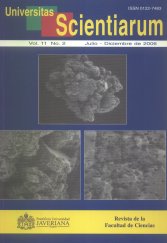Abstract
Entre noviembre de 2003 y febrero de 2004 se recopiló información sobre la composición fitoplanctónica y las características físicas y químicas de 10 humedales del altiplano cundiboyacense a fin dedeterminar el estado ecológico en que se encuentran. En cada humedal se tomaron muestras de fitoplancton mediante muestreo directo a 50 cm de profundidad y se midieron variables físicas y químicas. Posteriormente en laboratorio, se realizó la identificación y cuantificación de las algas con el método del microscopio invertido y el uso de claves taxonómicas. Los géneros algales más abundantes y comunes fueron Microcystis y Scenedesmus, y las especies Trachelomonas volvocina y Dactylococcopsis acicularis. El oxígeno registró bajos porcentajes de saturación, mientras que los ortofosfatos presentaron valores altos. Estos resultados biológicos y químicos indican una clara tendencia a la eutrofia y alta materia orgánica en estos cuerpos de agua.Univ. Sci. is registered under a Creative Commons Attribution 4.0 International Public License. Thus, this work may be reproduced, distributed, and publicly shared in digital format, as long as the names of the authors and Pontificia Universidad Javeriana are acknowledged. Others are allowed to quote, adapt, transform, auto-archive, republish, and create based on this material, for any purpose (even commercial ones), provided the authorship is duly acknowledged, a link to the original work is provided, and it is specified if changes have been made. Pontificia Universidad Javeriana does not hold the rights of published works and the authors are solely responsible for the contents of their works; they keep the moral, intellectual, privacy, and publicity rights. Approving the intervention of the work (review, copy-editing, translation, layout) and the following outreach, are granted through an use license and not through an assignment of rights. This means the journal and Pontificia Universidad Javeriana cannot be held responsible for any ethical malpractice by the authors. As a consequence of the protection granted by the use license, the journal is not required to publish recantations or modify information already published, unless the errata stems from the editorial management process. Publishing contents in this journal does not generate royalties for contributors.



